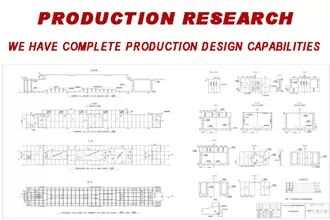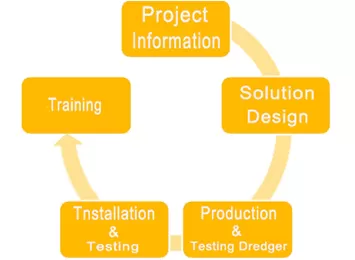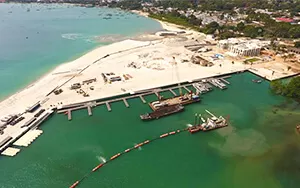
Dredge Production Technology
Catalog
Leader dredge has a complete production design capability, which is the basis for obtaining reliable and high-quality products. Dredge Technology’s continuous innovation is our direction
In recent years, with the improvement of the world’s environmental protection requirements, the declining energy reserves, the globalization of dredging projects, the complexity of working conditions, and the fierce competition, all have put forward proposals for energy saving, environmental protection and large-scale cutter suction dredges. In response to expectations and requirements, cutter suction dredges are rapidly developing toward automation, energy saving, and environmental protection. Therefore, research and development to meet the environmental regulations of various countries, reduce use costs, and improve construction capabilities are the direction of Leader dredge’s efforts.
The main direction of dredge production technology
The hull structure and force conditions of cutter suction dredges are very different from general ship types. In the design and production process of cutter suction dredges, the key technologies that need to be considered and applied are the following aspects.
1. Structural strength evaluation of cutter suction dredge
Since the cutter suction dredge has large grooves in the bow and stern, and there are a large number of complex engineering equipment placed on the hull on the main deck, its structural strength is not the same as the characteristics of ordinary ships. Strengthen the research and propose feasible calculation and verification methods.
2. Research on vibration characteristics of cutter suction dredge
In order to solve the dredge vibration problem caused by the large installed power, heavy equipment, and concentrated vibration sources of the large cutter suction dredge, Leader dredge will integrate the entire structure of the large cutter suction dredge except the superstructure and construction equipment. Vibration analysis and modal analysis.
3. Load analysis and research on large cutter suction dredge
Cutter suction dredges have large slots in the bow and stern to set up bridges and trolleys, large openings on the main deck and complex engineering equipment placed on the hull, which are different from conventional ship types. The ship is subjected to environmental loads during operation to conduct research, analyze various loads and motion responses acting on the cutter suction dredge under the design environmental conditions, and provide technical support for the design of the hull structure and various operating equipment.
4. Research on buffer technology of heavy steel pile trolley
In view of the characteristics of the medium and heavy steel pile trolley system on the cutter suction vessel that the working environment is wider and the stress condition is more severe, the buffer mechanism and technical realization of the positioning system of the double yoke heavy steel pile trolley are emphasized.
Production of environmentally friendly dredges
The goal pursued by environmentally-friendly dredges is to protect the atmosphere, water bodies, people, and soil as the starting point, with the pursuit of minimal impact on the environment and minimal interference to the comfortable environment of ship operators and surrounding residents. Leader Dredger requirements for dredge production technology
1. The Marpol Convention has:
- 1) Marpol Annex I-Requirements for the protection of water from pollution by ship oils (oil tank double-hull protection, oily sewage discharge standards, etc.)
- 2) Marpol Annex IV—Requirements for the protection of water bodies from domestic sewage from ships
- 3) Marpol Annex V-pollution prevention requirements for ship solid waste
- 4) Marpol Annex VI-Atmospheric pollution protection requirements, emission control of sulfides, nitrogen oxides, and greenhouse gases, etc.
2. Noise and vibration standards
Due to the particularity of dredging conditions, there is currently no international noise and vibration standard for dredges. The common practice is to refer to MSC337 (91) resolution and ISO 6954 (2000) criteria for navigation conditions. When dredging operations, try to take shock absorption measures to appropriately reduce vibration and noise. Let the construction and operation personnel in a relatively comfortable working environment.
3. Prevent water pollution
When the cutter suction dredge is constructed, new materials and new types of sealing systems are used for equipment and systems that are likely to pollute water bodies and leak.
The stern tube bearing is sealed with a non-leakage gas sealing system or multiple sealing systems, the hull shell uses anti-pollution paint, ballast water treatment equipment is used for international sailing ships across waters and seas, and the deck of the ship in waters requiring strict protection The machinery adopts biodegradable bio-lubricating oil. The above measures have reduced the pollution of water bodies and water sources by ships.
4. Ship noise and vibration reduction
Dredging ships are places where construction workers work and live for a long time. It is almost a three-shift work system of more than 16 hours a day. The experience of personnel comfort will have a greater impact on work efficiency and safety in production. The dredge built by Leader dredge has made useful attempts and explorations in cabin comfort technology. Starting from the main vibration source, reduce the generation of resonance frequency, use vibration isolation, damping, and increase damping materials to control the amplitude and vibration frequency, thereby reducing noise, reducing vibration and improving comfort.






